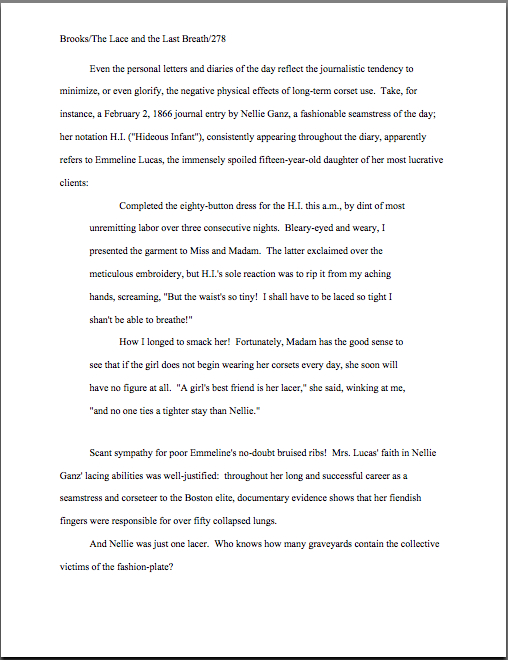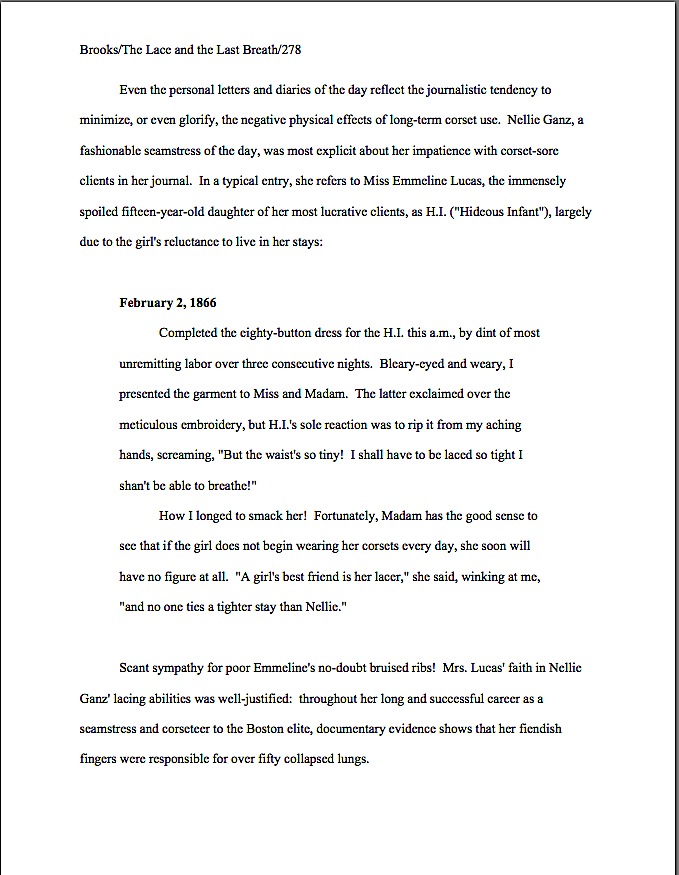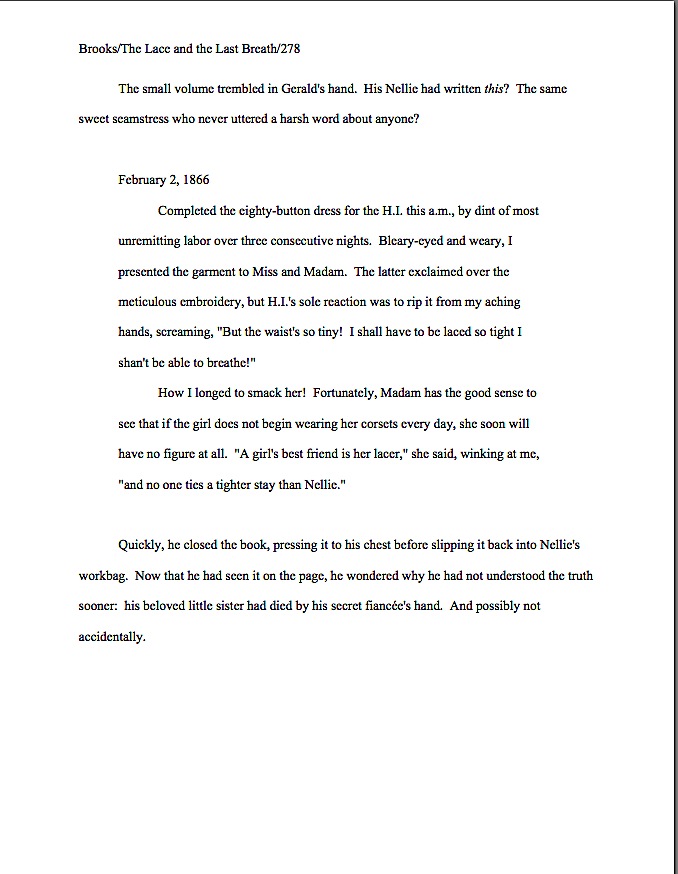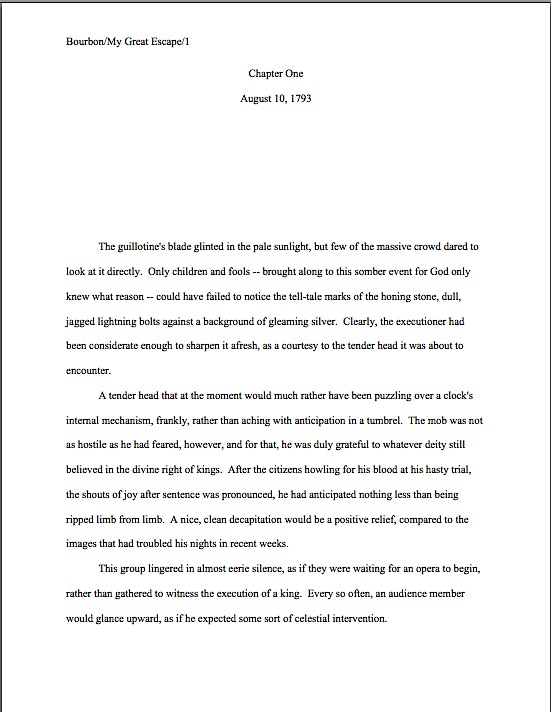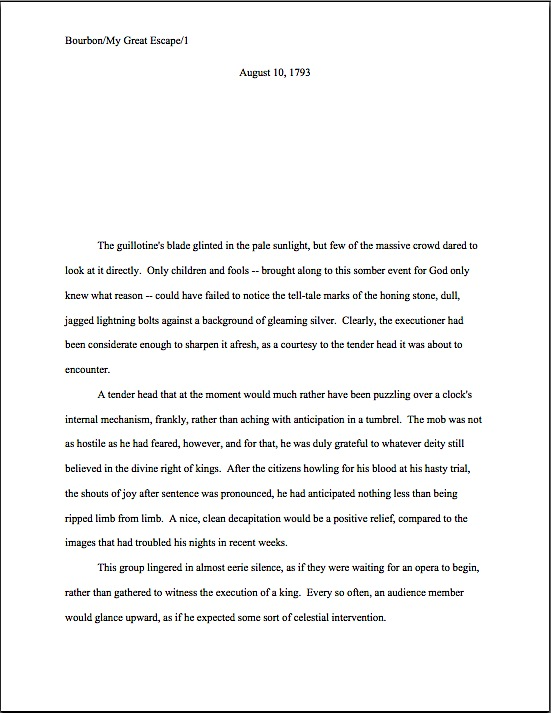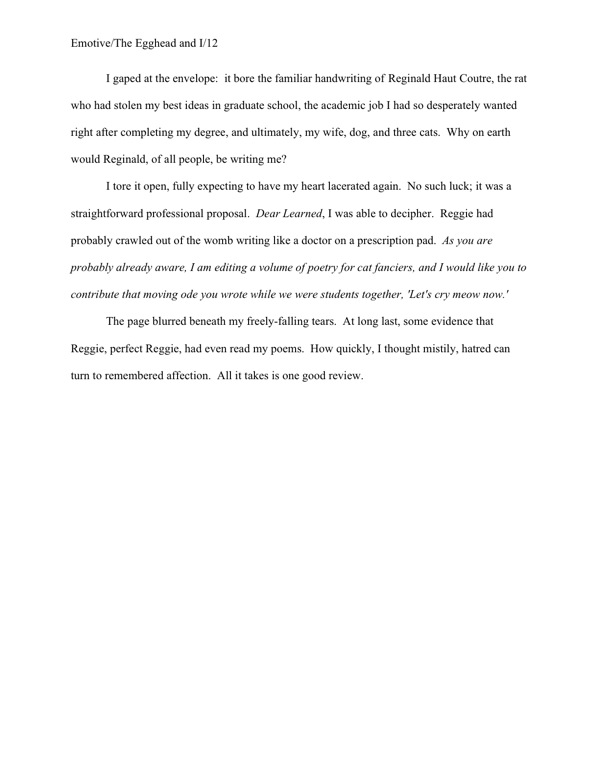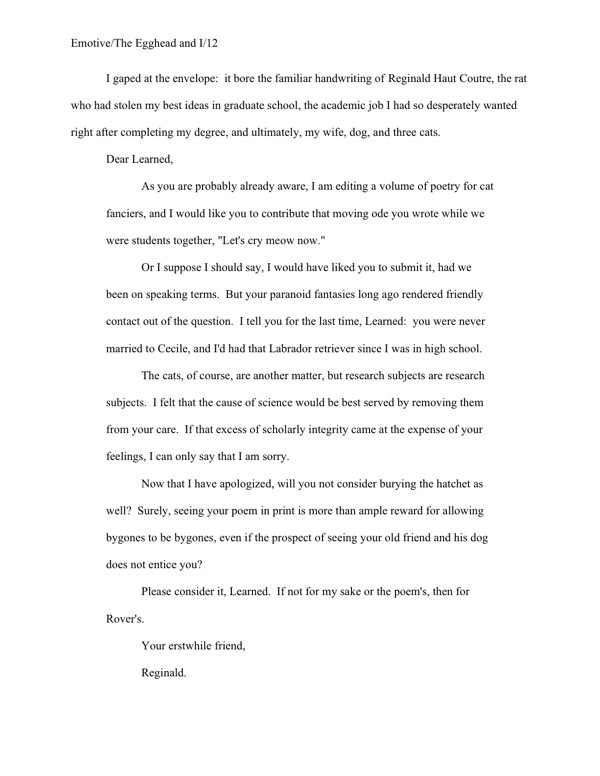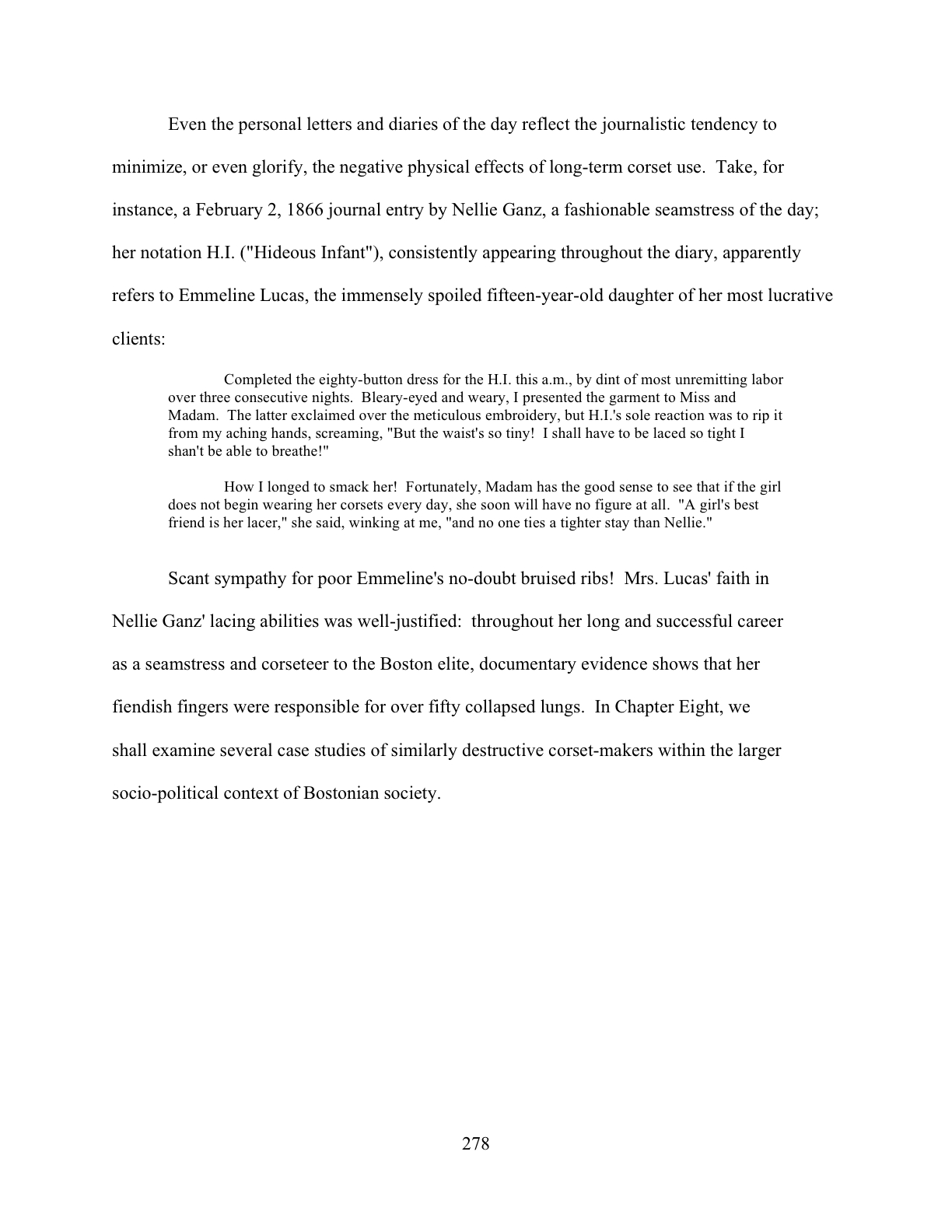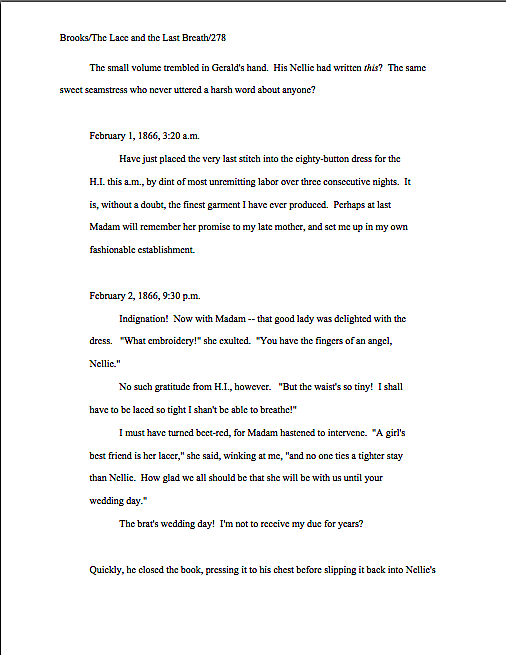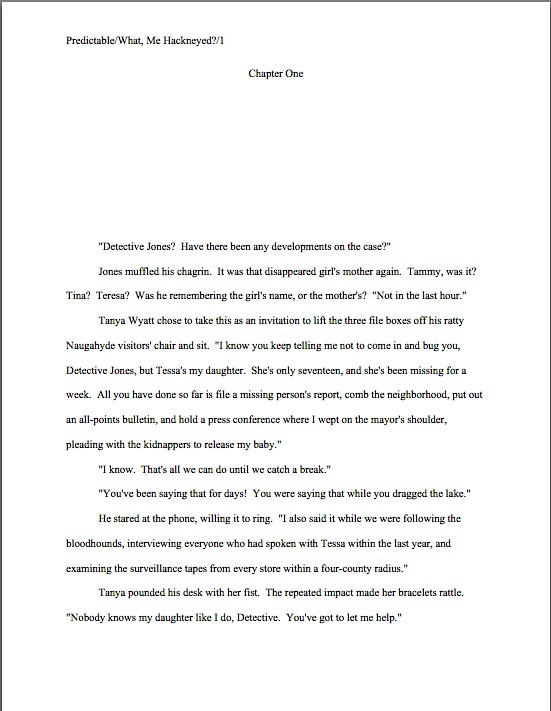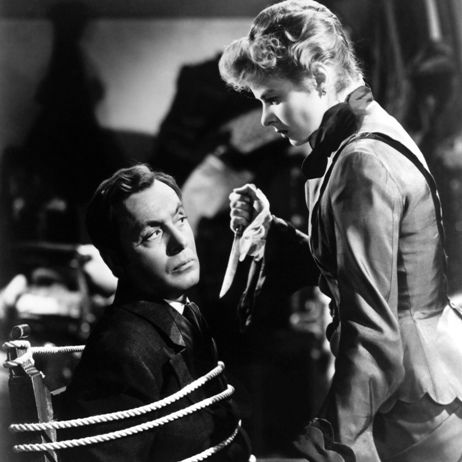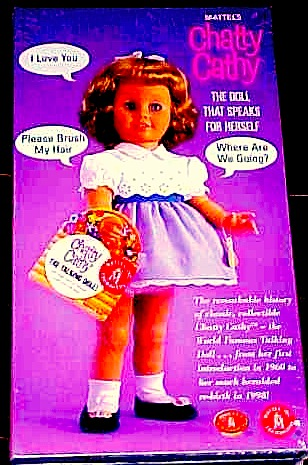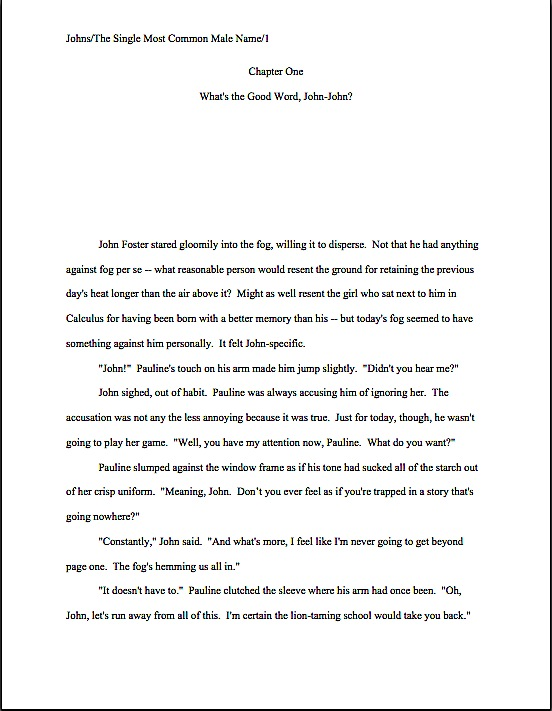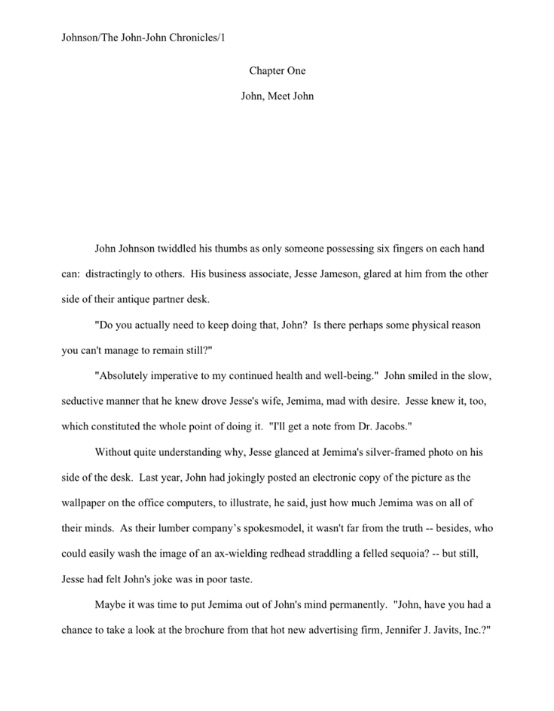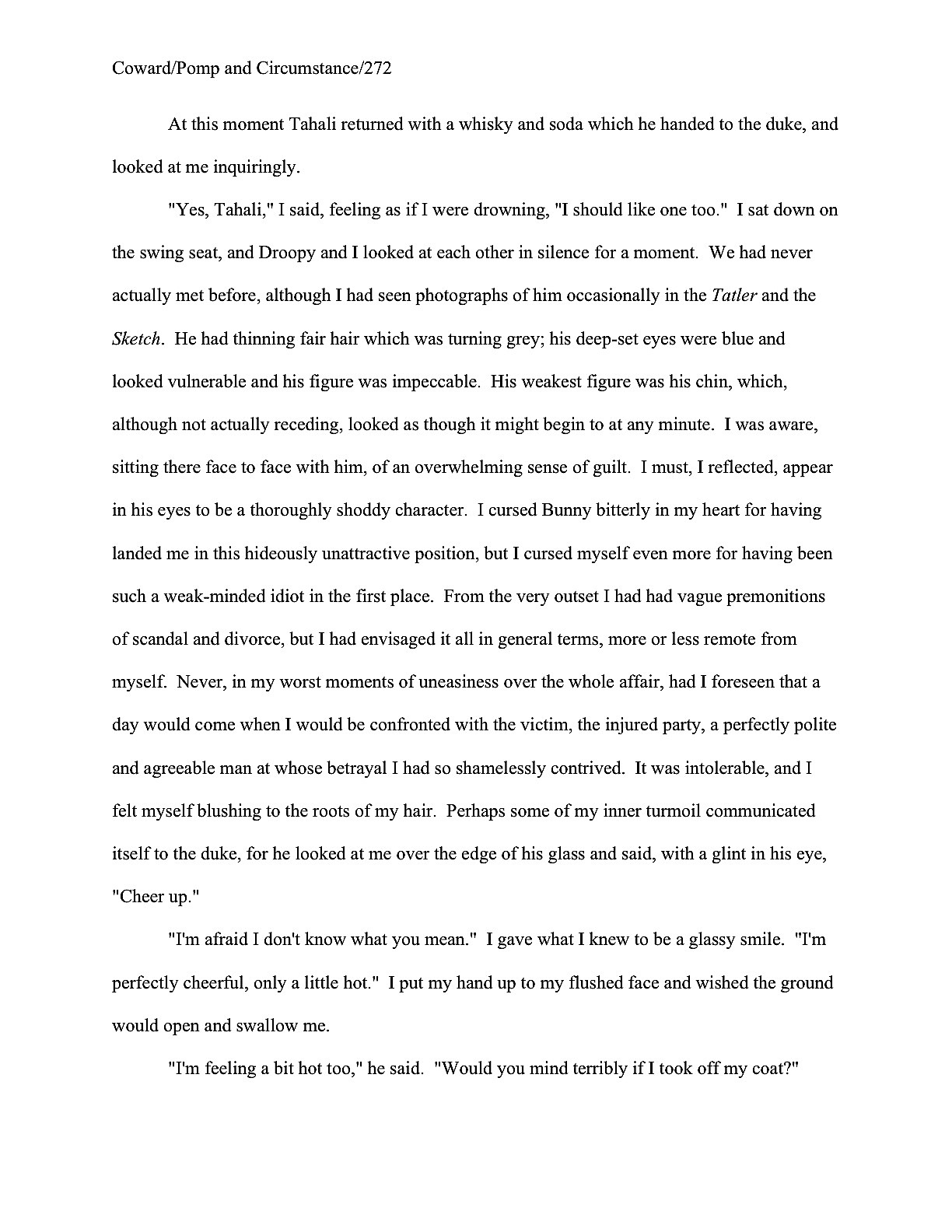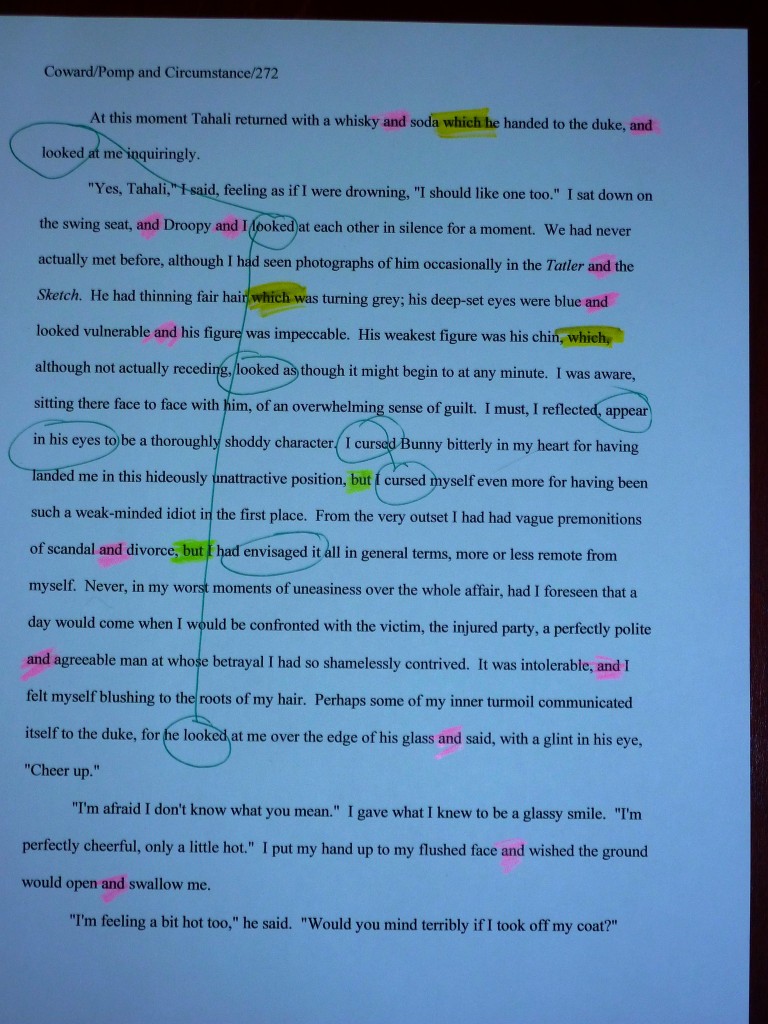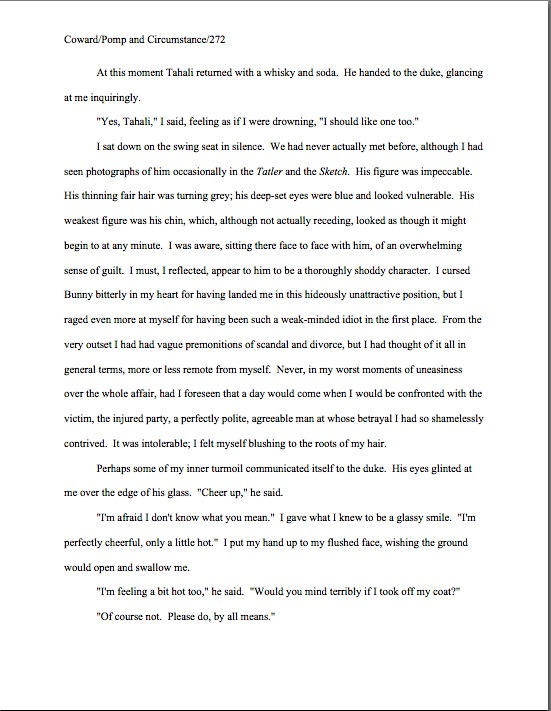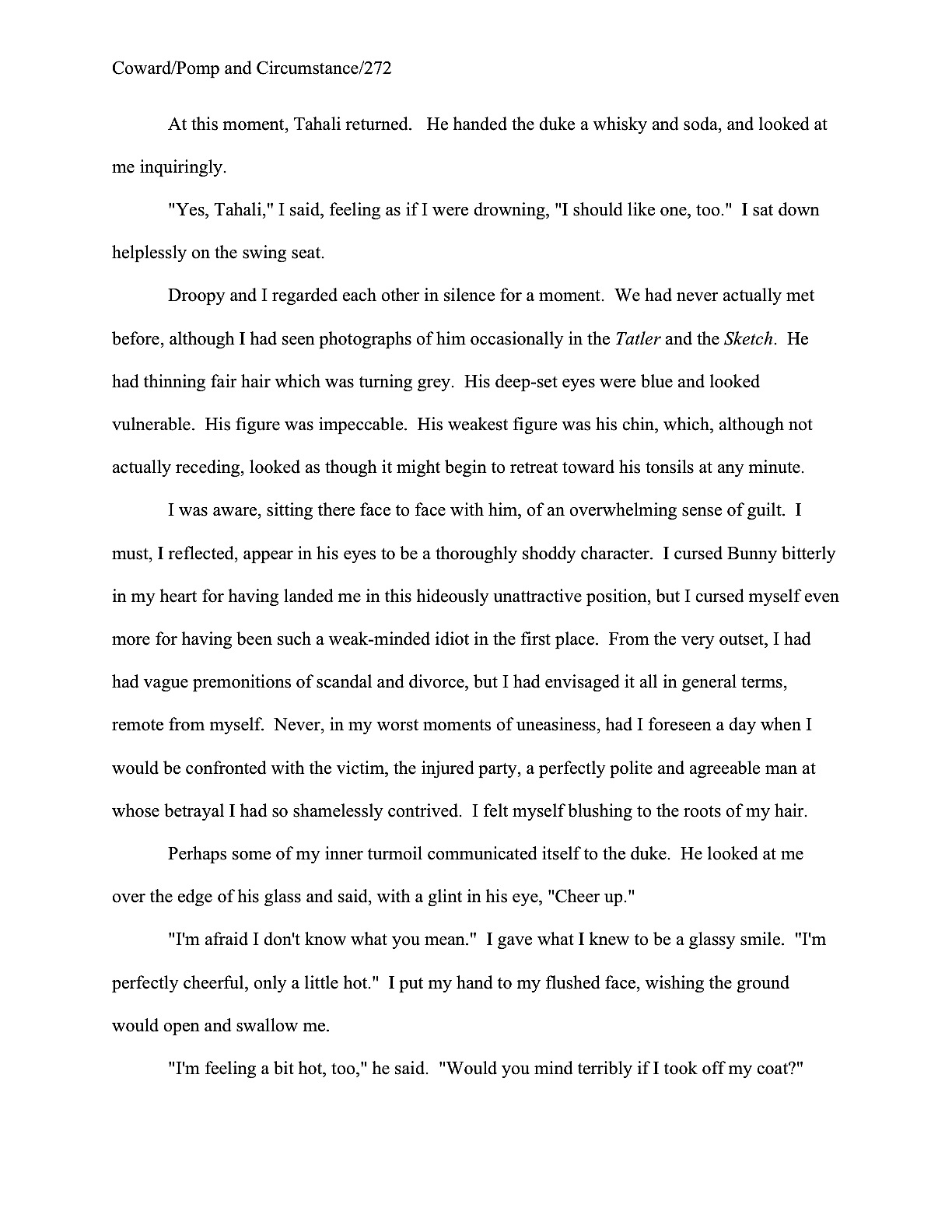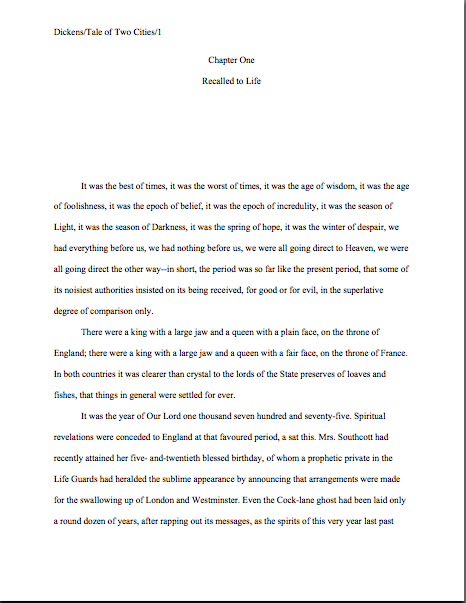



Since we’ve been on such a roll, discussing dialogue with vim, I’ve been rather reluctant to wrest us back to a subject that we absolutely must cover before we round out the Frankenstein manuscript series, conceptual redundancy. (Don’t worry, dialogue-huggers; I’ll be getting back to it in a few days.)
Actually, as topics go, it’s not all that far removed from edit-worthy dialogue: as I mentioned in passing just a few days ago, real-life dialogue tends to be rife with both phrase, idea, and even fact repetition. Add to that the simple truth that since it can take a heck of a long time to write a book, a writer does not always remember where — or even if — he’s made a particular point before, and even if he does, he may not be confident that the reader will remember it from 200 pages ago, and our old pal, Millicent the agency screener, ends up grinding her teeth and muttering, “You TOLD us that already!” a great deal more than any of us might like.
Yes, do take a moment to admire that last epic sentence. I doubt we’ll see its like again.
We’ve already talked about some reasons that redundant dialogue bugs your garden-variety Millicent so much, but at least the problem is easy for a reviser to spot. Heck, if your antagonist favors a catchphrase — please tell me she doesn’t — the fix is downright easy: a quick confab with Word’s FIND function, a few creative substitutions, and voilà! Problem solved.
Conceptual redundancy, however, requires both time for close reading of the entire manuscript and a retentive memory for a reviser to catch. Even if that reviser happens to have been blessed with both, after slaving over a Frankenstein manuscript for months or years on end, repeated or largely similar snippets of dialogue, explanations, and even relatively important plot points can seem…well, if not precisely fresh, at least not memorable from earlier in the latest draft.
Unfortunately, this quite predictable byproduct of revision burnout does not always fill professional readers with sympathy for the writer’s dilemma. Quite the opposite, in fact.
“Great jumping Jehoshaphat!” Millicent groans over many a submission. “Didn’t this writer bother to read this manuscript before sending it to us? Couldn’t she see that she TOLD us this already!”
To give you a sense of just why she might have this reaction, allow me to regale you with an anecdote from the dim reaches of my past. Some of you may remember it; it’s an example I have often used before when discussing conceptual redundancy.
I was six years old, standing in line for the Peter Pan ride at Disneyland, back in the days when the quality and popularity of the ride was easily discernable by the level of ticket required to board it. E was the best; I believe this particular ride was somewhere in the B- range.
Frankly, my tepid-to-begin-with enthusiasm had begun to fade practically as soon as I stepped into a queue of inexplicable length to cruise around an ersatz London with Peter, Wendy, and the gang. All brown eyes and braids, I had already spent several hours holding my mother’s hand while my father took my older brother on D and E ticket rides. And I was not particularly enamored of PETER PAN as a story: the business of telling children that if they only wish hard enough, their dead loved ones will come back from the dead has always struck me as rather mean.
Because, honestly, what does that story about the motivations of all of those kids whose late relatives persistently remain dead?
So I was not especially psyched to take this particular ride. It was merely one of the few the guidebook deemed appropriate to literary critics of my tender age. The longer we stood in line, the harder I found it to muster even the appearance of childish joie de vivre.
Why was I feeling so oppressed, the six-year-old in all of us cries? Because as each ship-shaped car took a new crew of tourists whirring into the bowels of the ride, Peter’s voice cried out, “Come on, everybody, raring to go-o-o-o!”
After about five minutes of listening to that annoying howl while inching toward the front of line, I started counting the repetitions. By the time it was our turn to step into the flying ship, Peter had barked that inane phrase at me 103 times.
It’s all I remember about the ride. I told the smiling park employee who liberated us from our ship at the end of the ride that it would have been far, far better without all of that phrase at the beginning.
He patted me on the back as he hurried me toward the exit. “I know,” he whispered. “By the end of the day, I want to strangle someone.”
I was mightily impressed by the power of so much mindless repetition. And that, my friends, is how little girls with braids grow up to be editors.
Actually, it’s probably fortunate that I was aurally assaulted by a cartoon character chez Mouse in my formative years — it’s helped make me very, very aware of just how much repetition is constantly flung at all of us, all the time. Not just in everyday conversations, but in TV and movies as well.
Most of us become inured through years of, well, repetition to the film habit of repeating facts and lines that the screenwriter wants to make sure the viewer remembers, information integral to either the plot (“Remember, Mortimer — cut the RED cord hanging from that bomb, not the yellow one!”), character development (“Just because you’re a particle physicist, Yvette, doesn’t mean you’re always right!”), or both (“You may be the best antiques appraiser in the British Isles, Mr. Lovejoy, but you are a cad!”)
My all-time favorite example of this phenomenon — again, this may seem a tad familiar to some of you, but that sort of is the point here — came in the cult TV series Strangers With Candy, a parody of those 1970s Afterschool Special that let young folks like me into esoteric truths like Divorce is Hard on Everyone in the Family, Outsiders are Teased, and Drugs are Bad. In case, you know, kids might not have picked up on any of that.
The writers and producers of the Afterschool Specials seemed genuinely concerned about the retentiveness of its young viewers’ memories, or perhaps our general level of intelligence: it was rare that any point was made only once — or that the fate of the Good Kid Who Made One Mistake was not obvious from roughly minute five of the program. True to this storytelling tradition, Strangers With Candy’s heroine, Jerri Blank, often telegraphed upcoming plot twists by saying things like, “I would just like to reiterate, Shelly, that I would just die if anything happened to you.”
Moments later, of course, Shelly is toast.
It was funny in the series, of course, but foreshadowing is substantially less funny to encounter in a manuscript, particularly if your eyes are attuned to catching repetition, as many professional readers’ are. Characters honestly do say things like, “But Ernest, have you forgotten that I learned how to tie sailors’ knots when I was kidnapped by pirates three years ago?”
Seriously, Millicent sees this all the time. Yes, even when the first 50 pages of the manuscript dealt with that very pirate kidnapping. And every time such a reference is repeated, another little girl with braids vows to grow up to devote her life to excising all of that ambient redundancy.
At base, conceptual repetition is a trust issue, isn’t it? The writer worries that the reader will not remember a salient fact crucial to the scene at hand, just as the screenwriter worries that the audience member might have gone off to the concession stand at the precise moment when the serial killer first revealed — wait for it — that he had a lousy childhood.
Wow — who could have predicted THAT? How about anyone who has seen a movie within the last two decades?
Television and movies have most assuredly affected the way writers tell stories. As we discussed earlier in this series, one of the surest signs that a catch phrase or particular type of plot twist has passed into the cultural lexicon is the frequency with which it turns up in manuscript submissions.
That’s a problem, because one of the best ways to assure a submission’s rejection is for it to read just like half the submissions that came through the door that day. We all know how agents and editors feel about manuscripts that bore them, right? In a word: next!
Come closer, and I’ll tell you a secret: repetition is boring. Really boring. As in it makes Millicent wish she’d gone into a less taxing profession. Like being a test pilot or a nuclear physicist.
Why, you ask? Here’s another secret: people who read manuscripts for a living are MORE likely to notice repetition of every variety than other readers, not less. (Perhaps Peter Pan traumatized them in their younger days, too.) Not only repetition within your manuscript, but repetition across manuscripts as well.
Yes, I am indeed saying what you think I’m saying. If 6 of the last 10 submissions Millicent has screened were conceptually redundant — a proportion not at all beyond the bounds of probability; it’s hard to strip a manuscript of them entirely, because they are so pervasive — your first repetition may annoy her as much as the eighth in her first manuscript of the day.
And no, there’s absolutely nothing you can do to affect where your work falls in her to-read stack. Thanks for asking, though.
All a savvy reviser can do is — speaking of concept repetition — re-read his submission or contest entry IN ITS ENTIRETY, IN HARD COPY, and OUT LOUD before allowing it to see the inside of a mailbox or hitting the SEND key. Minimizing the conceptual redundancy within the manuscript is the best (indeed, the only) insurance policy a writer can take out against the submissions read just before hers is to make hers as clean as possible.
I see some of you shrugging. You don’t think your manuscript could possibly fall prey to that level of bad luck? Okay, oh confident ones, here’s a challenge for you: sit down with your first 50 pages and highlight every line of dialogue in there that you’ve ever heard a TV or movie character say verbatim. Ever.
Was that giant slurping noise I just heard the sound of the blood rushing out of everyone’s faces at the realization of just how much dialogue that might potentially cover?
Did you find even one? Then you actually do need to worry about Millicent’s cry of, “Oh, no, not THIS again!”
For those of you who did not turn pale: what if I also ask you to highlight similar and culturally-common phrases in the narration, as well as the dialogue?
First-person narration is notorious for echoing the currently popular TV shows. So is YA. Often, it’s unconscious on the writer’s part: it’s brainwashing from all of that repetition.
Honestly, it would be surprising if common dialogue hadn’t made its way into all of our psyches: according to CASSELL’S MOVIE QUOTATIONS, the line, “Let’s get outta here!” is heard in 81% of films released in the US between 1938 and 1985.
Care to take a wild guess at just how often some permutation of that line turns up in submissions to agencies? Better yet, care to take a wild guess at how many agents and editors notice a particular phrase the second time it turns up in a text? Or the second time it’s turned up in a submission this week?
“Come on, everybody, raring to go-o-o-o!”
Unfortunately, just because a writer doesn’t realize that he’s been lifting lines doesn’t mean that an agency screener won’t notice and be annoyed by it. Particularly if three of the manuscripts she’s seen today have used the same line.
It happens. Or, to put it in Afterschool Special terms, Checking for Both Types of Repetition is Good.
I know, I know, it’s tempting to assume that you haven’t used any of the standard catchphrases or plot twists, but believe me, even the most innovative writers do it from time to time. And for good reason: the rest of the population is subjected to the same repetitive teleplays and screenplays as writers are.
Over time, people do tend to start to speak the way they would if they were playing themselves onscreen. A writer of very good hardboiled mysteries tells me that he is constantly meeting private detectives who sound like Sam Spade, for instance.
But remember — once again, this concept should be at least slightly familiar by now — just because people do or say something in real life doesn’t mean it will necessarily be interesting translated to the printed page.
Check. Weed out both repetition within your manuscript AND material unconsciously borrowed from TV and movies. Or, better yet, have a good reader you trust check for you. (And if you’re not sure whether a particular twist or line is common enough to count, film critic Roger Ebert maintains a database of them.)
Often, it’s surprising how small a textual change will turn an incipient cliché into a genuinely original moment. A writer cannot perform that magic trick, however, without first identifying where it should be applied.
Is your head aching from all of the homework I’ve heaped upon you already today? Oh, but I’m far from done.
For starters, here’s a pop quiz: did any of you sharp-eyed self-editors happen to catch the really, really subtle test of your conceptual editing skills cleverly concealed in this post so far?
If your hand immediately shot into the air, accompanied by a vigorous shout of, “By Jove, Anne, I’m glad you brought this up; it’s been driving me mad. Your comments on conceptual redundancy were themselves conceptually redundant. You’ve made some of the points above two or three times — and via examples you’ve used before, too. How relieved I am to hear that you did it on purpose!” not only should you award yourself a full seventeen gold stars for the day, but you should start thinking about offering your services to your writer friends as a first reader.
You, my friend, are starting to read like Millicent the agency screener and Mehitabel the contest judge. Please, for the sake of your sanity, do not attempt to ride the Peter Pan ride anytime soon.
Even if you were not actively annoyed by my repeating myself, you may well have been a trifle insulted by it. Repeating a concept, fact, or sentence too often — or even once, if the bit in question was particularly memorable the first time around — does convey an impression to readers that the author does not trust them to be able to recall salient matters without a narrative nudge. Or perhaps does not believe they are intelligent enough to figure out even self-evident logical connections without assistance.
What other purpose, after all, would a writer have for producing a sentence like I would just like to reiterate, Shelly, that I would just die if anything happened to you?
“In heaven’s name, why must anyone leap to such an unflattering conclusion?” scream those who currently have pages under Millicent’s critical eye. “I could see being a trifle annoyed by hearing a similar argument a week apart, but why would any sane creature have such an intensely negative reaction to it?”
A couple of very sane reasons, actually. First, the Millicents of this world aren’t typically reading just one manuscript in any given day, but dozens. (Rejecting most of them on page 1 speeds up the screening process like you wouldn’t believe.) So in all likelihood, the manuscript that irritates her by repeating herself isn’t the only redundant submission she has handled that day — and certainly not that week. Conceptual redundancy is one of the more common manuscript megaproblems out there, cutting across lines of genre, book category, and the fiction/nonfiction divide.
All of which should sound annoyingly familiar by now, right? Getting the picture?
To be fair, Millicent was probably pretty even-tempered the first fifty times a narrative assumed that she couldn’t remember basic plot elements. Around the 750th time, however, it had gotten old.
By then, too, she would probably have figured out what an experienced editor could have told her — and this is the second sane reason a professional reader might find conceptual redundancy annoying: writers quite frequently retain multiple iterations of the same point simply because they like the writing of each section that discusses it.
Or, as I did above, because they have an illustrative anecdote that they’d really like to shoehorn into the text. (I admit it: I love the Peter Pan example.) Either way, conceptual redundancy is a signal that a manuscript requires quite a bit more revision.
You can feel more homework coming, can’t you? Clever you; you must have seen this movie before.
(1) Print out all or part of any pages you plan to submit to Millicent or anyone remotely like her.
You may use any part of your manuscript, of course, but as submissions tend to get rejected in the early pages — thus leaving the rest unread unfortunately often — page 1 is a dandy place to start.
(2) Read through it, using a highlighting pen — say, yellow — to mark every time the text repeats the same information.
If you have the time to get fancy, it will make your post-exercise life easier if you take the time to make notes on a separate sheet of every time a specific repetition occurs. That list will render figuring out which iteration to keep much, much easier.
(3) Using a different color of highlighter — pink is nice — mark the first couple of paragraphs (or even the scene) that immediately follows the repeated information.
Why, you ask? Hold your horses; I’m building suspense.
(4) Go back and re-read the yellow sections. Are all of them genuinely necessary for the reader to follow what’s going on? Or could some of them be cut without endangering the reader’s ability to follow the plot?
In answering question #4, assume that the reader is of normal intelligence and average memory, but is reading your book in a single sitting. (Millicent’s boss probably will read it in installments, but Millicent often will not.) Ditto with a contest entry: Mehitabel generally reads each one just once.
(5) Immediately after reading each yellow section, re-read the pink section that follows it. Are all of the highlighted bits actually adding something new to the plot, characterization, or argument? Or are they included primarily because you kind of liked how they sounded?
If it’s the latter, don’t be too hard on yourself: the old writing chestnut kill your darlings was coined for a reason. Remember, this is need not be the only book you ever write; you needn’t include every nice piece of writing that falls off your fingertips.
Save something for the sequel, for heaven’s sake. You needn’t always be raring to go-o-o-o.
(6) Be especially attentive to those pink bits in first-person narratives, memoirs — or in a real-life story told as fiction. Are these sections necessary to the story you’re telling, or are they included merely because these things happened in real life?
Often, this is another of Millicent’s most cherished pet peeves — and this one is usually shared by her boss and the editors to whom the agent typically sells. Far too much of the time, memoirists (and novelists who write in the first person) forget that writing the truth from a sympathetic point of view is not enough to make a good book — it must also be an engaging story.
Ditto with novelists who incorporate the real into the texts: just because something actually happened does not mean that it will necessarily be interesting to read. Or add to the storyline of a book.
Gee, where have I heard all of this before?
Judicious cutting is especially important when writing the real. No reader, however intrigued by a premise, wants to hear everything that ever happened to a character, any more than he wants to plow through a complete list of every object in a room where an important scene occurs. Include only what your story needs to make it shine.
Now that I have alerted you to the twin dangers of factual redundancy intended to remind readers of salient points (“As I mentioned back in Ch. 2, Eleanor, I stand to inherit a hefty chunk of change when my Uncle Fritz dies.”) and screen clichés that have made their way into real life (“Say ‘ah,’” kindly Dr. Whitehairedman told the terrified child.), it’s only fair to mention that both types of repetition also tend to be, I am happy to report, some of the easiest lines for a self-editor to identify and cut.
Redundant sentences can often be trimmed wholesale, with no cost to the text at all. And clichés, like pop culture references and jokes that don’t quite work, are often digressions in a scene or dialogue, rather than integral to it. Much of the time, they can be deleted without adding any additional writing.
Which is a pretty good indicator all by itself that a line should be cut anyway, actually: if you wouldn’t miss a sentence if it were gone, it should probably go.
Take, for instance, the following piece of purple prose, full of sentences just begging to hop into the tumbrel and ride to the guillotine. As you read, think about just how much trimming could occur without harming the relationships or plot of the scene:
Marcus Aurelius paced the room, frowning, revisiting in his mind his last encounter with Cardinal Richelieu, two months before, when they had shot those rapids together in the yet-to-be-discovered territory of Colorado. Despite hours of manly good fellowship and moments of undeniable passion, they had not parted friends. The powerful holy man was known for his cruelty, but surely, this time, he would not hold a grudge.
“Can I bum a cigarette?” Marcus asked, to buy more time to recap the plot in his head.
Richelieu laughed brutally, but with an undertone of affection. “How on earth did you pick up the habit? Tobacco had not come to Europe in your time.” He shook two out of the pack and stuck both into his mouth. “And barely in mine.”
He lit the pair and handed both to his erstwhile lover. They sat in silence for a moment, the smoke winding its way around the cardinal’s red hat and through the halo of St. Jerome, who was standing nearby.
Finally, Marcus Aurelius decided he could take this brutal wordlessness no longer. “I’ve come for some information, Armand.”
Richelieu’s hand tightened on the sawed-off shotgun that seldom left his side. “You’re wasting your time.”
“I’m not leaving until you tell me what I need to know.”
“It might,” St. Jerome suggested gently, “go a little faster if you were more specific.”
“Yes, do come to the point.” Richelieu waved a bejeweled hand toward his wall-sized TV screen. “American Idol is on in an hour.”
Yes, text-retentive ones you are correct: I’ve used this example before, too. No exertion of laziness has been spared to drive today’s points home. (Oh, and happy Bastille Day, Cardinal.)
But tell me, how much cutting did you manage to do? Other than the obvious, that is — as a major Stoic, Marcus Aurelius clearly would not have folded so quickly under the pressure; I give you that.
Even ignoring the philosophical problems and the time travel that seems to have happened here, there’s room for some fairly painless trimming that would speed up the scene. Take a gander:
Marcus Aurelius paced the room, frowning. The powerful holy man before him was known for his cruelty, but surely, he could not still be holding a grudge about how they’d parted in Colorado. “Please tell me, Armand. For old times’ sake.”
Richelieu laughed brutally, but with an undertone of affection. The smoke from his cigarette wound its way around his red hat and through the halo of St. Jerome, leaning against the fridge.
“It might,” St. Jerome suggested gently, “be helpful if you were more specific about what you wanted.”
“Yes, do come to the point.” Richelieu lifted a bejeweled hand from his sawed-off shotgun to wave languidly toward his wall-sized TV screen. “American Idol is on in an hour.”
That’s 123 words, down from 253, a substantial cut obtained through the simple expedient of removing the movie clichés (the double cigarette bit was straight out of the Bette Davis vehicle NOW, VOYAGER, right?) and unnecessary conceptual repetition.
How did I know, within the context of an isolated excerpt, that the references to the Colorado scene probably referred to something that happened earlier in the book? Call it well-honed editorial instinct: this kind of micro-flashback almost invariably recaps a scene told more fully elsewhere – and when it isn’t shown at some point in the book, it probably should be.
Seem paradoxical? It isn’t.
A micro-flashback usually provides one or more characters’ motivation(s) in the scene occurring at the moment: here, the earlier romantic interlude has set the stage for Marcus’ belief that Richelieu would do him a favor, as well as Richelieu’s current attitude toward Marcus. Clearly, then, this past episode is important enough to the development of both characters that the reader would benefit from seeing it in its entirety.
Which makes removing the micro-flashback from this scene an easy editorial call. To work as character development — as explanatory asides that deal with motivation must, right? — the reader really should have this information prior to the scene.
What would that mean for our example? Well, if the Colorado rapids scene did happen earlier in the book, the micro-flashback would be redundant; if it did not, the micro-flashback is not memorable enough in itself to make a lasting impression upon the reader.
In other words: snip, snip.
Long-time readers of this blog, chant it with me now: emotionally important scenes are almost always more powerful if they are SHOWN as fully-realized scenes, rather than merely summarized. (Oh, come on — you don’t want to know what happened on those rapids?) Keep an eye out for those micro-flashbacks, my friends: they’re often signposts telling the editor what needs to be done to improve the manuscript.
In this case, the cut can only help: by removing the explanatory summary here, the author will need to make sure that the earlier scene made enough of an impression upon the reader that she will remember it by the time Marcus Aurelius comes looking for information on page 348.
Yes, even if that means going back and writing the earlier scene from scratch. Sometimes, adding a fresh scene is actually a quicker and easier fix for a manuscript that drags than merely trimming the existing text.
The metaphor that I like to use for this kind of revision comes from flower arranging, believe it or not — and yes, I’ve used it before. I simply will not have my long-time readers walking away from this post willing to tolerate conceptual redundancy.
Think of your draft as a wonderful bouquet, stocked with flowers you have been gathering over the last couple of years. It’s lovely, but after it has been rejected a few dozen times, you’ve come to realize that maybe it’s too big for the room in which the agent of your dreams wants to place it; it does not fit comfortably into the only vase she has.
So you need to trim it — but how? A good place to start would be to pull out half of the daisies; a few are nice, but handfuls make the daisy point a bit more often than necessary.
Then you could start searching for the flowers that have wilted a little, or are not opening as well as others. Pulling out the wilted flowers renders the bouquet both smaller and prettier – and the ones that wilt the fastest are the ones that are borrowed from other sources, like movie tropes, which tend to date a book, anyway.
Already, your bouquet is looking lighter, more vibrant, but you liked the color that some of the discarded flowers added. Rather than pulling the cast-off blooms out of the compost bin and putting them back into the vase (as most self-editors will do), adding a fresh flower here and there is often more beneficial to the overall beauty of the bouquet.
Be open to the possibility that trimming your manuscript may well mean writing a fresh scene or two, for clarification or character development. Search your manuscript for micro-flashbacks that may be telling you what needs further elucidation, as well as darlings that could be, if not killed, then at least set aside to grace another book. If you apply a truly diligent eye, you may well find that a single, well-developed scene inserted early on will replace scores of micro-flashbacks down the line.
It happens. All the time. Like a good joke, motivation goes over better with the reader if it can be presented cleanly, without excess in-the-moment explanation.
Okay, it’s well past the time for me to go-o-o (curse you, Pan!) for today. Keep those creative spirits riding high, everyone, and as always, keep up the good work!




